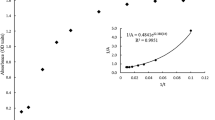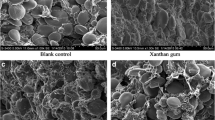Abstract
In order to investigate the effect of NaCl levels (1.5%, 3.5%, 5.5% and 13%) on the taste and texture of dry-cured ham, TPA, myofibril ultrastructure, proteolysis index and free amino acids were evaluated. The proteolysis index (30.76% ± 2.05–11.88% ± 1.90), cohesiveness (0.74 ± 0.04–0.60 ± 0.01), springiness (0.83 ± 0.03–0.71 ± 0.04), and the total free amino acids (9885.3 mg/100 g ± 677.98–3505.15 mg/100 g ± 378.20) decreased with the increase of salt addition, while the hardness (8701.99 g ± 513.37–12057.53 g ± 783.89) and adhesiveness (− 15.73 ± 2.53 to − 32.01 ± 4.95) increased with the increase of salt addition. The myofibril ultrastructure indicated that hams with higher proteolysis index (> 20%) showed more obvious degradation of M-line and Z-disk, and more disordered fiber structure, which was closely related to the degradation of myofibrillar proteins (actin, desmin and troponin-T). Among four groups, the dry-cured ham with 5.5% salt had the highest levels of moisture (45.73% ± 1.13) and umami amino acids (1422.77 mg/100 g ± 119.87), as well as the lowest chewiness (3346.89 ± 121.19). The ham with 5.5% salt also had higher sensory scores of texture (4.83 ± 0.1), taste (5.50 ± 0.2) and overall acceptance (5.51 ± 0.09) as compared to the ham added with other salt levels. These results indicated that 5.5% NaCl treatment showed positive effects on the texture and taste of dry-cured ham, which meets the consumer's demand for dry-cured meat products.



Similar content being viewed by others
References
I. Bondoc, E.V. Şindilar, Controlul sanitar veterinar al calității și salubrității alimentelor (Ion Ionescu de la Brad, Iaşi, 2002), pp. 84–124
E.V. Șindilar, A. Chidon-Radivanschi, I. Bondoc, The evaluation of some quality parameters and the nitrite residues on several ranges of sausages. Lucrare şt. USAMV Iaşi 3(2), 685–690 (2001)
E. Zanardi, S. Ghidini, M. Conter, A. Ianieri, Mineral composition of Italian salami and effect of NaCl partial replacement on compositional, physico-chemical and sensory parameters. Meat Sci. 86(3), 742–747 (2010)
C.Y. Zhou, D.D. Pan, Y. Bai, C.B. Li, X.L. Xu, G.H. Zhou, Evaluating endogenous protease of salting exudates during the salting process of Jinhua ham. Food Sci. Technol. 101, 76–82 (2019). https://doi.org/10.1016/j.lwt.2018.11.026
M. Middeke, Salzkonsum und kardiovaskuläres Risiko. Der Internist 53, 14–19 (2012). https://doi.org/10.1007/s00108-011-2888-2
F.P. Cappuccio, Cardiovascular and other effects of salt consumption. Kidney Int. Suppl. 3, 312–315 (2013). https://doi.org/10.1038/kisup.2013.65
I. Bondoc, European regulation in the veterinary sanitary and food safety area, a component of the European policies on the safety of food products and the protection of consumer interests: a 2007 retrospective. Part one: the role of European institutions in laying down and passing laws specific to the veterinary sanitary and food safety area. Universul Juridic, Supliment, 12–15 (2016)
I. Bondoc, European regulation in the veterinary sanitary and food safety area, a component of the European policies on the safety of food products and the protection of consumer interests: a 2007 retrospective. Part three: directives. Universul Juridic, Supliment, 20–23 (2016)
N.J. Aburto, A. Ziolkovska, L. Hooper, P. Elliott, F.P. Cappuccio, J.J. Meerpohl, Effect of lower sodium intake on health: systematic review and meta-analyses. BMJ 346, 326 (2013). https://doi.org/10.1136/bmj.f1326
W.H.O. Population-based prevention strategies for childhood obesity. Report of a WHO forum and technical meeting, Geneva, 15–17 December 2009
W.H.O/F.A.O. Diet, nutrition and the prevention of chronic diseases. Report of a joint WHO/FAO expert consultation, Geneva, 28 January-1 February 2002
M. Aliño, R. Grau, D. Baigts, J.M. Barat, Influence of sodium replacement on the salting kinetics of pork loin. J. Food Eng. 95, 551–557 (2009). https://doi.org/10.1016/j.jfoodeng.2009.06.016
D. Andronikov, L. Gašperlin, T. Polak, B. Žlender, Texture and quality parameters of Slovenian dry-cured ham Kraški Pršut according to mass and salt levels. Food Technol. Biotechnol. 51, 112–122 (2013)
L. Martín, J. Córdoba, T. Antequera, M. Timón, J. Ventanas, Effects of salt and temperature on proteolysis during ripening of Iberian ham. Meat Sci. 49, 145–153 (1998). https://doi.org/10.1016/s0309-1740(97)00129-0
C.Y. Zhou, C. Wang, C.B. Tang, C. Dai, Y. Bai, X.B. Yu, C.B. Li, X.L. Xu, G.H. Zhou, Label-free proteomics reveals the mechanism of bitterness and adhesiveness in Jinhua ham. Food Chem. 297, 125012 (2019). https://doi.org/10.1016/j.foodchem.2019.125012
C.Y. Zhou, C. Wang, J.H. Cai, Y. Bai, X.B. Yu, C.B. Li, X.L. Xu, G.H. Zhou, Evaluating the effect of protein modifications and water distribution on bitterness and adhesiveness of Jinhua ham. Food Chem. 293, 103–111 (2019). https://doi.org/10.1016/j.foodchem.2019.04.095
M. Garriga, N. Grebol, M. Aymerich, J. Monfort, M. Hugas, Microbial inactivation after high-pressure processing at 600 MPa in commercial meat products over its shelf life. Innov. Food Sci. Emerg. Technol. 5, 451–457 (2004). https://doi.org/10.1016/j.ifset.2004.07.001
E. Fulladosa, X. Serra, P. Gou, J. Arnau, Effects of potassium lactate and high pressure on transglutaminase restructured dry-cured hams with reduced salt content. Meat Sci. 82, 213–218 (2009)
K. Yamamoto, Y. Yoshida, J.I. Morita, T. Yasui, Morphological and physicochemical changes in the myosin molecules induced by hydrostatic pressure. J. Biochem. 116, 215–220 (1994)
C. Pérez-Santaescolástica, J. Carballo, E. Fulladosa, J.V. Garcia-Perez, J. Benedito, J.M. Lorenzo, Effect of proteolysis index level on instrumental adhesiveness, free amino acids content and volatile compounds profile of dry-cured ham. Food Res. Int. 107, 559–566 (2018)
J. Ruiz-Ramírez, J. Arnau, X. Serra, P. Gou, Effect of pH24, NaCl content and proteolysis index on the relationship between water content and texture parameters in biceps femoris and semimembranosus muscles in dry-cured ham. Meat Sci. 72(2), 185–194 (2006)
I. Cilla, J. Altarriba, L. Guerrero, M. Gispert, L. Martínez, C. Moreno, P. Roncalés, Effect of different Duroc line sires on carcass composition, meat quality and dry-cured ham acceptability. Meat Sci. 72, 252–260 (2006). https://doi.org/10.1016/j.meatsci.2005.07.010
X.J. Du, Y.Y. Sun, D.D. Pan, Y. Wang, C.R. Ou, J.X. Cao, Change of the structure and the digestibility of myofibrillar proteins in Nanjing dry-cured duck during processing. J. Sci. Food Agric. 98(8), 3140–3147 (2018). https://doi.org/10.1002/jsfa.8815
C.Y. Zhou, Y. Wang, D.D. Pan, J.X. Cao, Y.J. Chen, Y. Liu, Y.Y. Sun, C.R. Ou, The changes in the proteolysis activity and the accumulation of free amino acids during Chinese traditional dry-cured loins processing. Food Sci. Biotechnol. 26, 679–687 (2017). https://doi.org/10.1007/s10068-017-0089-z
Z. Li, X. Li, X. Gao, M. Du, D.Q. Zhang, Effect of inhibition of μ-calpain on the myofibril structure and myofibrillar protein degradation in postmortem ovine muscle. J. Sci. Food Agric. 97, 2122–2131 (2017)
ISO. Sensory analysis-Methodology-General guidance for establishing a sensory profile, ISO. Geneve, Method ISO 13299 (2016)
P.N. Seong, K.M. Park, S.M. Kang, G.H. Kang, S.H. Cho, Effect of particular breed on the chemical composition, texture, color, and sensorial characteristics of dry-cured ham. Asian-Australas J. Anim. Sci. 27(8), 1164–1173 (2014). https://doi.org/10.5713/ajas.2013.13770
S.K. Jin, D.K. Shin, I.C. Hur, Effects of moisture content on quality characteristics of dry-cured ham during storage. Food Sci. Anim. Resour. 31(5), 756–762 (2011). https://doi.org/10.5851/kosfa.2011.31.5.756
E. Puolanne, J. Peltonen, The effects of high salt and low pH on the water-holding of meat. Meat Sci. 93(2), 167–170 (2013)
M.C. Hughes, J.P. Kerry, E.K. Arendt, P.M. Kenneally, P.L.H. McSweeney, E.E. O’Neill, Characterization of proteolysis during the ripening of semi-dry fermented sausages. Meat Sci. 62(2), 205–216 (2002)
R. Harkouss, T. Astruc, A. Lebert, P. Gatellier, O. Loison, H. Safa, P.S. Mirade, S. Portanguen, E. Parafita, Quantitative study of the relationships among proteolysis, lipid oxidation, structure and texture throughout the dry-cured ham process. Food Chem. 166, 522–530 (2015)
C. Sárraga, M. Gil, J. Arnau, J.M. Monfort, R. Cussó, Effect of curing salt and phosphate on the activity of porcine muscle proteases. Meat Sci. 25, 241–249 (1989). https://doi.org/10.1016/0309-1740(89)90042-9
G.H. Zhou, G.M. Zhao, Biochemical changes during processing of traditional Jinhua ham. Meat Sci. 77(1), 114–120 (2007). https://doi.org/10.1016/j.meatsci.2007.03.028
A. Del Olmo, J. Calzada, P. Gaya, M. Nuñez, Proteolysis, texture, and sensory characteristics of Serrano hams from Duroc and Large White pigs during dry-curing. J. Food Sci. 78(3), 416–424 (2013)
R. Virgili, G. Parolari, C. Schivazappa, C.S. Bordini, M. Borri, Sensory and texture quality of dry-cured ham as affected by endogenous cathepsin B activity and muscle composition. J. Food Sci. 60, 1183–1186 (1995). https://doi.org/10.1111/j.1365-2621.1995.tb04551.x
J.A. Garcı́a-Garrido, R. Quiles-Zafra, J. Tapiador, M.D. Luque de Castro, Activity of cathepsin B, D, H and L in Spanish dry-cured ham of normal and defective texture. Meat Sci. 56, 1–6 (2000)
G. Parolari, R. Virgili, C. Schivazappa, Relationship between cathepsin B activity and compositional parameters in dry-cured hams of normal and defective texture. Meat Sci. 38, 117–122 (1994)
F. Yang, S.N. Jia, J.X. Liu, P. Gao, D.W. Yu, Q.X. Jiang, Y.S. Xu, P.P. Yu, The relationship between degradation of myofibrillar structural proteins and texture of superchilled grass carp (Ctenopharyngodon idella) fillet. Food Chem. 301, 125278 (2019). https://doi.org/10.1016/j.foodchem.2019.125278
S. Pornrat, T. Sumate, S. Rommanee, K. Sumolaya, W.L. Kerr, Changes in the ultrastructure and texture of prawn muscle (Macrobrachuim rosenbergii) during cold storage. Food Sci. Technol. 40, 1747–1754 (2007). https://doi.org/10.1016/j.lwt.2007.01.006
E.H. Lonergan, W. Zhang, S.M. Lonergan, Biochemistry of postmortem muscle—lessons on mechanisms of meat tenderization. Meat Sci. 86, 184–195 (2010). https://doi.org/10.1016/j.meatsci.2010.05.004
C.Y. Zhou, D.D. Pan, Y.Y. Sun, C.B. Li, X.L. Xu, J.X. Cao, G.H. Zhou, The effect of cooking temperature on the aggregation and digestion rate of myofibrillar proteins in Jinhua ham. J. Sci. Food Agric. 98(9), 3563–3570 (2018). https://doi.org/10.1002/jsfa.8872
R.G. Taylor, G.H. Geesink, V.F. Thompson, M. Koohmaraie, D.E. Goll, Is Z-disk degradation responsible for postmortem tenderization? J. Anim. Sci. 73, 1351–1367 (1995). https://doi.org/10.2527/1995.7351351x
S. Li, X. Xu, G. Zhou, The roles of the actin-myosin interaction and proteolysis in tenderization during the aging of chicken muscle. Poult. Sci. 91, 150–160 (2012). https://doi.org/10.3382/ps.2011-01484
D.Y. Wang, M.H. Zhang, S.Y. Deng, W.M. Xu, Y. Liu, Z.M. Geng, C. Sun, Postmortem changes in actomyosin dissociation, myofibril fragmentation and endogenous enzyme activities of grass carp (Ctenopharyngodon idellus) muscle. Food Chem. 197, 340–344 (2016)
P. Kęska, J. Stadnik, Taste-active peptides and amino acids of pork meat as components of dry-cured meat products: an in-silico study. J. Sens. Stud. 32, e12301 (2017). https://doi.org/10.1111/joss.12301
R. Virgili, G. Parolari, C.S. Bordini, C. Schivazappa, M. Cornet, Free amino acids and dipeptides in dry-cured ham. J. Muscle Food. 10, 119–130 (1999). https://doi.org/10.1111/j.1745-4573.1999.tb00390.x
M. Careri, A. Mangia, G. Barbieri, L. Bouoni, R. Virgili, G. Parolar, Sensory property relationships to chemical data of Italian-type dry-cured ham. J. Food Sci. 58, 968–972 (1993). https://doi.org/10.1111/j.1365-2621.1993.tb06090.x
J.M. Wang, G.F. Jin, W.G. Zhang, D.U. Ahn, J.H. Zhang, Effect of curing salt content on lipid oxidation and volatile flavour compounds of dry-cured turkey ham. Food Sci. Technol. 48(1), 102–106 (2012)
E.Y. Youssef, C.E.R. Garcia, M. Shimokomaki, Effect of salt on color and warmed over flavor in charqui meat processing. Braz. Arch. Biol. Technol. 46(4), 595–600 (2003). https://doi.org/10.1590/s1516-89132003000400014
M. Moczkowska, A. Półtorak, A. Wierzbicka, Impact of the ageing process on the intensity of post mortem proteolysis and tenderness of beef from crossbreeds. Bull. Vet. Inst. Pulawy 59, 361–367 (2015)
C. Coutron-Gambotti, G. Gandemer, S. Rousset, O. Maestrini, F. Casabianca, Reducing salt content of dry-cured ham: effect on lipid composition and sensory attributes. Food Chem. 64, 13–19 (1999)
J.A. Ordóñez, E.M. Hierro, J.M. Bruna, L.D.L. Hoz, Changes in the components of dry-fermented sausages during ripening. Crit. Rev. Food Sci. Nutr. 39, 329–367 (1999). https://doi.org/10.1080/10408699991279204
Acknowledgements
This work was supported by National Key R&D Program of China (2016YFD0401502), Science Foundation of Zhejiang Province (LR18C200003), National Natural Science Foundation of China (31871825), and K.C. Wong Magna Fund in Ningbo University.
Author information
Authors and Affiliations
Corresponding authors
Additional information
Publisher's Note
Springer Nature remains neutral with regard to jurisdictional claims in published maps and institutional affiliations.
Rights and permissions
About this article
Cite this article
Zhou, Y., Zhou, C., Pan, D. et al. The effect of sodium chloride levels on the taste and texture of dry-cured ham. Food Measure 14, 2646–2655 (2020). https://doi.org/10.1007/s11694-020-00511-3
Received:
Accepted:
Published:
Issue Date:
DOI: https://doi.org/10.1007/s11694-020-00511-3




